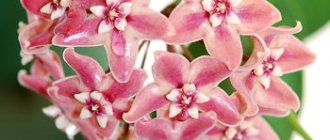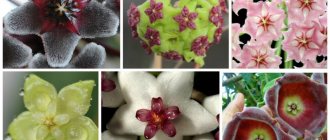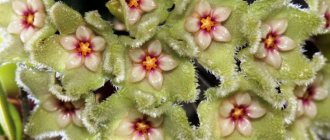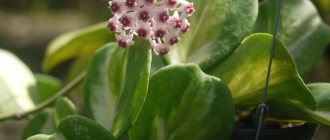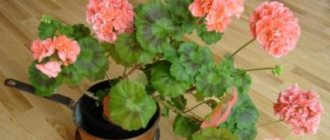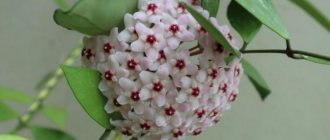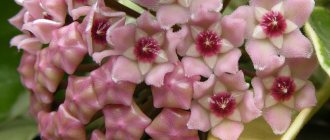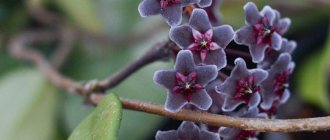Plants » Flowers
1
282
Article rating
Kira Stoletova
An exotic guest from Indonesia and Malaysia, Hoya Lacunosa, has taken root and adapted in European countries. Now it is also successfully grown by flower growers in the former CIS countries. A plant with decorative leaves and amazing fragrant flowers adorns the living collections of millions of people.
Hoya lacunosa photo
Description of the plant
Botanical name: Hoya lacunosa.
This epiphytic hoya in nature lives in close connection with the trees around which it twines and with ants. It is also called concave because of the unusual shape of the leaves - they are small, diamond-shaped, with a curved core. On the back side the leaves have a glossy shine. The shoots do not curl, but cascade. This is a distinctive feature of the Lacunosa species.
The flowers are unusual, white, shaped like fluffy balls with a creamy star in the center. Collected in inflorescences of 20 pieces, drops of nectar do not stand out on the surface. The aroma is pleasant, sweetish, reminiscent of expensive perfume, intensifies at night. Hoya blooms from May to August. Sometimes it can produce flower stalks in early spring - in March.
Description of species with photos
Hoya lacunusa has the following subspecies.
Miniature plant. In sunlight, the leaves have a dark purple, beetroot hue. Globular inflorescences of cream color with a yellow center. The flower size is 6 mm, there are more than 20 of them in the inflorescence.
Snow Caps
Silver leaves. Their width is 2 cm, and their length is up to 5 cm. The corolla and crown of the flower are snow-white, diameter 10 mm. This variety grows quite slowly compared to its counterparts.
Hoya Lacunosa Eskimo
The plant has diamond-shaped leaves of a dark green color with a glossy sheen.
The flowering process does not take long to occur and blooms profusely. It also smells similar to women's perfume.
Royal Flush
It is distinguished by small leaves of a dark bronze color with silver inclusions on them. Leaf length 6mm. Royal Flush inflorescences are round, white. The new sprout has a reddish-brown tint.
Varieties
The Lacunosa species has several artificially bred varieties. Each of them has characteristics of growth, flowering and maintenance. To successfully grow a flower, you need to decide on its variety so as not to make mistakes in creating favorable conditions for it.
Eskimo
The variety is interesting in the shape of its leaves - they are small and heart-shaped. True, they acquire this appearance only in bright light. In partial shade they stretch out and lose their decorative effect. There are two varieties - just Eskimo and Eskimo Silver. The latter is distinguished by a silvery coating on the leaves, the so-called “splash”.
It blooms with white graceful buds with a pleasant hyacinth aroma. The variety received the name “Eskimo” for the color and shape of the flowers - they are creamy-white, fluffy, very reminiscent of the famous ice cream. The aroma intensifies at night. For active flowering, the plant needs a lot of light.
Laos
The leaves are large, dense, with cream-colored specks. In the light they turn brown and the specks turn white. The vines are powerful and do not break under their own weight. They do not require special support. The variety has a long flowering period. The aroma of the buds is reminiscent of incense.
Hoya lacunosa popsicle photo
Heart shape leaf
The shape of the hoya leaves of this variety is heart-shaped, but it becomes so in bright light. In the shade, the leaves begin to stretch and lengthen. The emerald green color gives way to pale turquoise. The flowers are white with a delicate aroma that intensifies at night.
Bold
The leaves have an interesting pattern of depressed and protruding areas. The vines do not curl, but hang down in a cascade. Flowers are spherical, cream and white. The peduncles are elongated, the buds are collected in inflorescences of 15-18 pieces. The aroma of flowers is reminiscent of chocolate.
Tove
The variety is distinguished by pale purple flowers and diamond-shaped leaves up to 6 cm long. In good light, the leaves turn burgundy. Hoya Tove does not tolerate heat; at high temperatures it begins to hurt and is affected by pests.
Langkawi Island
A miniature variety with the smallest leaves of a dark, almost black color. There is a light silvery splash across the surface of the sheet. It blooms with white, fluffy buds, with a cream star in the middle. Has a pleasant incense scent.
Snow Caps
The castings are elongated, light green, with white splashes. The vines reach 5 meters in length, and aerial roots form on them in large numbers. The flowers, as is clear from the name of the variety, resemble snow caps. They are fluffy, white, smell pleasant and strong.
Hoya Lacunosa Royal Flush
Royal Flush
The leaves can change color depending on the lighting. In partial shade they are green, monochromatic, without inclusions. In the light, the leaf acquires a bronzed tint; in good light, silvery specks appear. It blooms rarely and only with excess sun. The variety is resistant to diseases, both bacterial and viral.
Types of flower
Hoya carnosa
Nurseries offer the following varieties of crops:
- Hoya lacunosa aff. (similar) - has a slight difference in the size and color of the foliage;
- Hoya lacunosa v. snow caps - with dark green foliage and silver inclusions, growing up to 12 cm in length and 2 cm in width, with snow-white inflorescences;
- Hoya lacunosa v. pallidiflora Hook f. - determined by small leaves, more common in the Thai and Malaysian regions.
Hoya Lacunosa Eskimo is of interest not only to professionals, but also to inexperienced gardeners. The unpretentious liana blooms quickly and rarely gets sick, and does not require complex supervision or special skills. If you follow the cultivation rules, the plant will delight you with its unusual aroma throughout the summer.
Purchase and adaptation
Immediately after purchase, the plant needs adaptation.
Hoya does not like to move. Even a simple move from one window to another is stressful for her. After being transported from another country, it is generally incredibly difficult for a flower to get used to the new microclimate and conditions of detention.
Important! For the first 2-3 weeks, the plant should be kept separately from other indoor flowers. Exotic imported varieties can be infected, and local specimens grown from cuttings or seeds are not always healthy. Hoya needs to be closely monitored, noticing the slightest changes in its condition.
After two weeks, it is advisable to transplant the wax plant into a new pot with soil suitable for succulents. The first transplant is carried out regardless of the season. Then the plant is placed in a permanent place and is no longer moved. It is better to hang the vine in a pot on the wall or on a window where it will have enough light.
Landing rules
Hoya is very light-loving, so the place for it should be sunny and warm. South-eastern or southern windows are preferable. You can’t keep hoyas on the northern ones, but on the western ones you will have to add additional lighting. Pots with flowers look great right on the window or on the wall near the window. Once you have chosen a place, you no longer need to turn the flowerpot.
Hoya lacunosa tove
The soil for hoya should be as soft and loose as possible. Purchased soil for cacti is suitable, but it must be diluted with baking powder. Then you should additionally add a little leaf turf. Hoya is an epiphyte, which means it needs leaves and humus for nutrition. The further growth and flowering of the plant depends on the correct soil.
Useful information: advice from experienced flower growers
Hoya loves to take warm baths
Hoya does not tolerate being in dry soil very well, so moisture should be carefully monitored.
If the flower has buds, it is no longer recommended to move it to another place.
After winter is over, wax ivy should be treated with the following procedure: immerse it in a bath of warm water (about 30°C) for one hour.
To strengthen the immune system, the vine is watered with a decoction of potatoes, which contains a lot of potassium.
Yellowed leaves, as a rule, indicate incorrect maintenance conditions: excessive moisture or lack thereof, hypothermia, burns from direct sunlight, drafts.
Hoya lacunosa "Eskimo" is of interest not only for experienced gardeners, but also for beginners. They are attracted by the minimal time and effort required to grow wax ivy and the fast and captivating flowering. And, of course, we must not forget about the intoxicating aroma of an exotic plant.
Video about proper transplantation of Hoya:
Noticed a mistake? Select it and press Ctrl+Enter to let us know.
The necessary conditions
Hoya Lacunosa is unpretentious; apartment conditions suit her perfectly. However, it is worth considering some features of these succulent vines. By ignoring them, you can even ruin the flower.
Humidity
All succulents are drought-resistant. They do not need high humidity. Even 30-35% is enough for the plant to feel great. Sometimes on hot days the hoya is sprayed with warm water from a spray bottle. Once a year, the plant is even given a “shower” by placing it in a bathtub and watering it from the rain. But this must be done when the plant does not bloom.
Temperature
The average temperature is +22-25°C. In winter, a decrease to 16 ° C is possible, although this is not necessary. Wax ivy does not need dormancy as much as other flowering plants. Although flowering after it will always be more magnificent.
At constant temperatures around +22 °C, hoya can bloom all year round. Few inflorescences will form, but a super pleasant aroma will reign in the house. Lowering temperatures to +15 °C and below is undesirable for a heat-loving vine. At +10 °C it can die.
Lighting
Hoya needs a lot of light; it should always fall the same. The flower does not tolerate rearrangements. The brightness and even color of the leaves depends on the degree of lighting. It can vary from pale green to deep burgundy. In bright light, the plant produces more flower stalks and blooms longer.
Hoya Retuza - growing features
How to make a tree dry out - folk remedies
In general, the plant has a calm and not capricious character. The only thing is that when cutting hoya, it takes a long time to adapt. Cuttings can stand for up to 6 months without growing. But, having firmly taken root, they begin to grow lashes with bunches of leaves-needles.
Caring for ampelous hoya is simple and consists of just a few procedures:
- Water the bush no earlier than the top layer of soil in the pot dries out (if wintering is cool, watering should be done less frequently).
- In summer you can spray, but not during flowering.
- In the spring-summer period, feed with a mineral complex once a month.
This unusual vine prefers warmth. The hoya pot should be kept in a room where in winter the temperature does not drop below 15°C. If you follow these recommendations, you can grow a gorgeous bush with long, lush vines.
Video about growing Hoya Retuza
Among the variety of indoor plants, tropical hoya (wax ivy) deserves special attention.
Thanks to its decorative qualities, it has long attracted the attention of many flower growers from all over the world.
It surprises with the variety of varieties, species and varieties, of which there are just over fifty and another 430 in botany still have an uncertain status.
Care
The rules for caring for Hoya are simple. This is a persistent plant, which is commonly called “unkillable”. However, certain care features exist and every gardener should know them.
Hoya lacunosa super popsicle
Watering
Thick, fleshy leaves and stems accumulate moisture; the plant can go without water for a long time. But you shouldn’t test its strength. In summer, hoya should be watered 2-3 times a week so that the entire earthen ball is moistened.
If the substrate is chosen correctly, it will be difficult to overwater the flower. Excess liquid will flow into the drainage holes, the roots will not rot.
Still, do not overdo it with watering. In winter, if the temperature in the room drops, it can generally be reduced to a minimum - once a week.
Feeding
From March to October, the plant is fertilized and fed with mineral complexes. In early spring, it is important for the flower to increase its green mass. This requires a lot of nitrogen. Closer to flowering time they provide more phosphorus and potassium.
Suitable fertilizers:
- Uniflor cactus;
- Florovit;
- Etisso;
- Pocon;
- Agricola for cacti and succulents;
- Good power;
- Stimovit.
Growing pains
The plant has good disease resistance
Hoya Lacunosa is a flower that is very resistant to various diseases. In other words, he almost does not suffer from dangerous infections. This is a great advantage over other plants. But growth difficulties sometimes arise due to improper care.
Pests
Harmful insects can interfere with the comprehensive development of ivy. The most common:
- scale insect;
- mealybug;
- mite;
- whitefly
Harmful insects feed on the sap of the flower. This leads to exhaustion, wilting, and drying out of the plant.
It is not difficult to destroy pests, you just need to notice them in time. Careful treatment with an insecticide for indoor plants (according to the instructions) will help quickly get rid of dangerous insects.
Diseases
Hoya diseases:
- Viral. Thickenings and spots appear on the leaves, which are almost untreatable.
- Bacterial. They are manifested by a change in the condition of the shoots and leaves (they become sticky and soft). Treatment is carried out with products containing copper.
- Fungi. The roots rot and plant growth stops.
Transfer
It is not worth replanting the waxweed often. Young vines are transferred to new flowerpots once a year, older ones - once every 3-4 years. The most crucial moment is the first transplant after purchase. The plant is completely removed from the pot, the peat soil is shaken off, and the roots are washed off with water.
Drainage is poured into a pre-prepared flowerpot of the same size as the purchased one. Suitable materials include shards, pebbles, and pieces of polystyrene foam. Then the soil for cacti is mixed with baking powder (perlite, vermiculite) and poured into a container. The flower is placed inside, the roots are sprinkled, but not crushed. The plant can be watered a little.
Reproduction methods
Hoya is characterized by simple and trouble-free propagation. In many varieties, aerial roots form directly on the vines. This makes it easier to root the cuttings. There are also other ways to propagate wax ivy.
Seeds
At home, seeds rarely ripen, but they can be found on sale. They are first soaked in stimulants, then sown in a light substrate. The container is covered and placed under a regular incandescent lamp to create a greenhouse effect. The temperature should be within +27 °C.
Mouths appear on days 10-14. From this moment on, it is necessary to collect condensate and periodically ventilate the “greenhouse”. Gradually, the seedlings will become accustomed to the microclimate in the house. After a month, the greenhouse can be removed. They will grow to the state of an adult plant for another 2.5-3 years.
Cuttings
The fastest and most reliable method. Cuttings are cut from vines; you can take segments with aerial roots. Each is dipped in Kornevin, then placed in the substrate. There is no need to cover the top. Rooting occurs in 2-3 weeks.
Hoya lacunosa snow caps
To speed up the process, you can raise the temperature and water the plant more often. As soon as young leaves appear, the plant is considered to have taken root favorably. Already next year, young hoya can bloom.
Leaf
If a leaf accidentally breaks off from a vine, you do not need to throw it away immediately. After keeping it in “Kornevin” for a day, it is planted in a very light and loose substrate. If the leaf has at least the rudiments of a petiole, there is a chance to grow a full-fledged seedling. The leaf takes root in 1-2 weeks. The attempt is considered successful if new shoots begin to grow next to the leaf.
Hoya tricolor home care
Characteristics:
One or more plants in a technical pot with a diameter of 6 cm without a flower pot (first photo). The pots can be purchased separately here.
You can also purchase fertilizers and other related products here.
The first photo is REAL and true!
DELIVERY:
Pickup (free) or mail. Estimated shipping cost for plants in pots ⌀ 5 cm = 150 rub. + 50 rub. every third plant). The cost of mailing plants in larger diameter pots is calculated individually, depending on the weight and size of the plants.
ATTENTION: Only seeds and assortment of items are sent by cash on delivery. Live plants are sent upon payment in advance. Use: Looks great as a stand-alone plant
Usage:
Looks great as a stand-alone plant.
Description:
Hoya is a genus of evergreen tropical vines or shrubs of the subfamily Lastovnevye, family Kutrovye, whose natural habitat is South and Southeast Asia, the west coast of Australia, Polynesia. Most species grow in open forests, using woody plants as support.
The length of an adult plant can reach 10 m. Young shoots without leaves are brownish-violet in color and turn green as the leaves appear. Aerial roots easily form on the shoots. With age, the shoots become woody.
The leaves are oval-shaped, pointed towards the end, shiny when young, later matte. There are several species with miniature leaves, but most species have leaves that are 5–8 cm long and 3–5 cm wide. Many species have fleshy leaves and can be classified as leaf succulents. With age, as the plant becomes woody, the leaves usually become noticeably thinner.
The star-shaped, five-membered bisexual flowers of Hoya are collected in umbrella-shaped inflorescences located on special rod branches, which do not die off after flowering, but lengthen from year to year. Pedicels are reddish, up to 5 cm in length. The diameter of the flower is 1-2 cm, in the center of the corolla there is a five-membered crown - a convex formation formed by fused parts of the flower, rising above the petals.
The flowers have a strong smell, and they also secrete nectar, which accumulates on them in the form of thick translucent drops - all this attracts large numbers of flying and crawling insects. Individual flowers stay on the plant for 2-3 weeks.
Hoya carnosa tricolor
refers to climbing succulent ornamental shrubs. It is distinguished by rather large, fleshy, juicy oval-shaped leaves. The flowers are waxy, plump, dense, approximately 1 cm in diameter. Their color ranges from pale pink to purple. Hoya fleshy is valued by botanists and breeders for its ease of crossing. Tricolor is distinguished by its original leaf color.
Care:
The plant should be illuminated 14-16 hours a day. It will not bloom in too dark a room. The scorching rays of the sun are undesirable - they burn the leaves. The best placement option is a western or eastern window.
The ideal temperature for normal growth and maintaining a decorative appearance is 22-25°C. The room where the plant is located must be regularly ventilated. The leaves of the plant need spraying.
The soil is kept slightly moist. In summer and spring, more abundant watering is allowed. Only soft and settled water is suitable for irrigation.
Hoya does not tolerate cold easily. When the air temperature drops below 15°C, the plant becomes sick and the leaves turn yellow.
Young plants are replanted every year, then every three years. For replanting, a pot that is larger than the previous one is always selected. During transplantation, shoots that are too long must be removed.
The preferred substrate is a mixture of 2 parts turf soil, 1 part peat, 1 part sand and 1 part humus. Sphagnum moss is added to retain moisture. But stagnation of moisture at the roots can be detrimental to the plant. The substrate must be loose and breathable. Charcoal and crushed bark are also added to the mixture. Complex fertilizers are used for fertilizing.
Diseases and pests
| Problem | Cause | Treatment | Prevention |
| Doesn't bloom | Little light and nutrients | Place in full sun and fertilize well | Do not remove the flowerpot from the light |
| Doesn't grow | Low nitrogen, poor lighting | Apply nitrogen fertilizer and expose to light | Follow the feeding regime |
| Leaves curl and dry out | Cold | Place the flowerpot in a warm room, place a heater nearby | Avoid sudden drop in temperature |
| Leaves fall | Dry air | Place the plant under the shower | Spray the leaves |
| Powdery mildew | Low humidity, the room is not ventilated | Tilt, Quadris, Skor, Topaz | Ventilate the room, spray with soapy water |
| Shchitovka | Warm, low humidity, the room is not ventilated | Karbofos, Neoron, Fitoverm | Maintain watering and humidity regime |
| Spider mite | High room temperature, dry air | Aktellik, Antiklesch, Fufanon | Maintain watering and humidity regime |
Possible problems in growing
Compared to its relatives, the culture has good immunity and rarely gets sick.
Pests
The main parasitic insects that attack the vine are:
- spider mite;
- aphids;
- mealybug;
- scale insect.
If pests are detected, the foliage is mechanically cleaned with a soap solution and sprayed with an insecticidal composition. The treatment is done several times until the parasite is completely destroyed.
Mealybug
Other problems
Liana does not tolerate excessive dryness of the earthen clod. After the buds appear, the containers cannot be rearranged. To awaken the plant after hibernation, you will need to take a bath by immersing it in water (30 degrees) for an hour. Strengthening the immune system is carried out with a decoction of potatoes.
Common cultural diseases include:
- bacterial infection - causes softening, stickiness of foliage and shoots, requires treatment with store-bought products containing copper;
- viral - determined by thickenings and spots on the foliage, practically cannot be treated, the plant slowly dies and requires being sent to quarantine;
- fungal - provokes rotting of the root system and stunting of growth, requires replacing the soil and treating the roots with activated carbon powder.
Important! Yellowness of the leaves indicates a violation of the maintenance rules: excessive waterlogging or drying out of the soil, burns on the leaf plates from the sun, staying for a long time in a cool room under drafts
